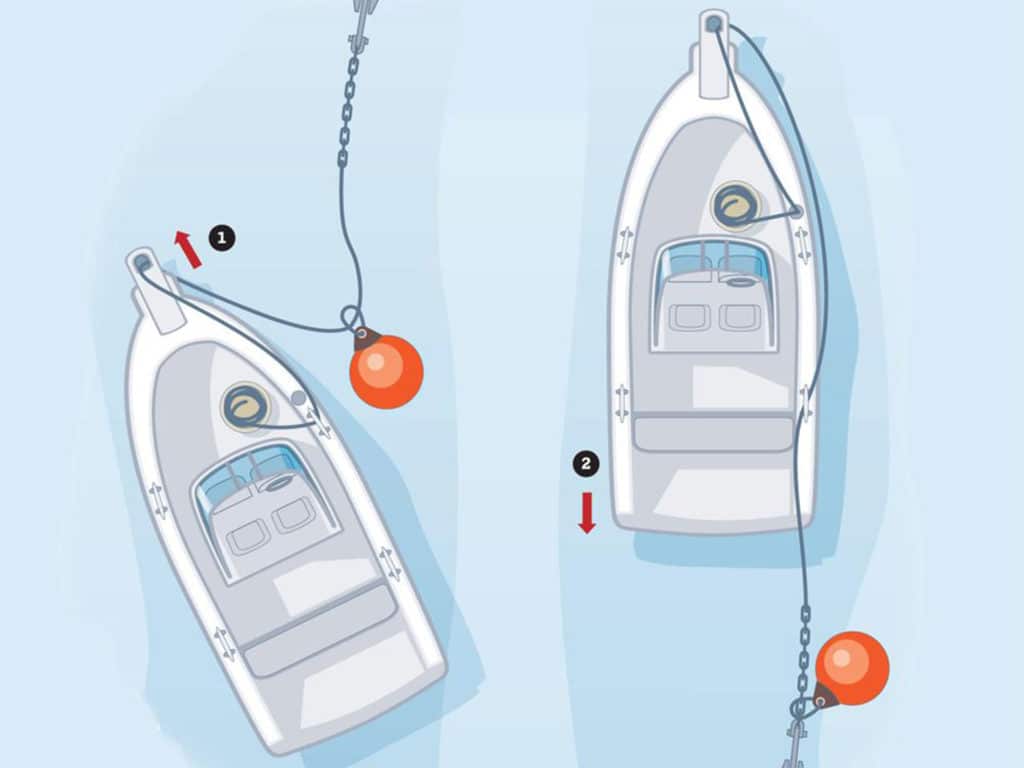
Having a windlass beats weighing anchor with your back by a measured mile. Yet a windlass costs some bucks, and not all boats have the space to fit one. Also, the slow drop of a power-out windlass makes it difficult to anchor precisely, compared with the speed with which a free-dropped anchor hits the bottom. Add learning new techniques and having a backup plan should the windlass break, and you’ve got the impetus for this instructional on using an anchor ball.
What Is It?
An anchor ball is a round fender with enough buoyancy to support a rode and anchor. A 20-inch-diameter ball has approximately 180 pounds of buoyancy and is the most popular size used by seasoned skippers. To this ball, it’s common to affix a three-foot trace of line (but see tip later). At the other end of the trace, attach a large carabiner snap. To this snap, connect a specialized piece of equipment called an anchor ring.
The Theory
Using an anchor ball is like heaving a line over a tree branch and connecting one end to a truck’s hitch in order to raise a heavy weight at the other end. Since limbs are rare on the water, run the rode through the ring, which is supported by the buoyancy of the ball. The boat is the truck, the ring and ball the limb.
The Practice
To haul anchor, place the anchor ring around the rode and snap the line to it. The snap connects the ball and also “closes” the ring, capturing the rode. Now power toward the anchor, angling off just a bit so you’re not quite running parallel to the rode. (1) A good, fast troll that provides confident steerage is fine.
You pass the anchor, which of course is on the bottom, and continue until the ball, with the rode captured in the ring, slides by the boat. Needless to say, you have to be careful not to run over the rode and foul the props. Here’s a tip I use to avoid that: Snap the ring tight to the ball instead of using the three-foot line.
With a long trace, the rode is three feet below the surface. But with a short trace, the ring is only a foot down, and so the rode is closer to the surface and above the level of most props.
Also, at this point I would have a crew member standing by to grab the rode as the ball passes by, bring it aboard and belay it to a stern cleat. With the rode tied at the stern, and you moving the boat forward, the chance for tangles are virtually eliminated.
Note that if you are solo, or don’t have solid crew aboard, you can leave the rode secured at the bow and continue heading forward. In that case, extra care is required on your part to avoid fouling the rode.
Crew or not, as you continue forward, the ball will descend the rode, and submerge as the anchor breaks free. The combination of the ball’s bouyancy and the boat’s pull lifts and yanks the anchor out backward, and the anchor surfaces with great commotion in the wake, with the flukes neatly hanging in the ring. Now all you do is haul in the virtually weightless ground tackle, or back up toward it if you like. (2)
As with any technique, it’s prudent to practice in clear, open water a few times before doing it for real. It’s easy as pie once you try.
The U.S. Coast Guard is asking all boat owners and operators to help reduce fatalities, injuries, property damage, and associated healthcare costs related to recreational boating accidents by taking personal responsibility for their own safety and the safety of their passengers. Essential steps include: wearing a life jacket at all times and requiring passengers to do the same; never boating under the influence (BUI); successfully completing a boating safety course; and getting a Vessel Safety Check (VSC) annually from local U.S. Coast Guard Auxiliary, United States Power Squadrons(r), or your state boating agency’s Vessel Examiners. The U.S. Coast Guard reminds all boaters to “Boat Responsibly!” For more tips on boating safety, visit www.uscgboating.org.








